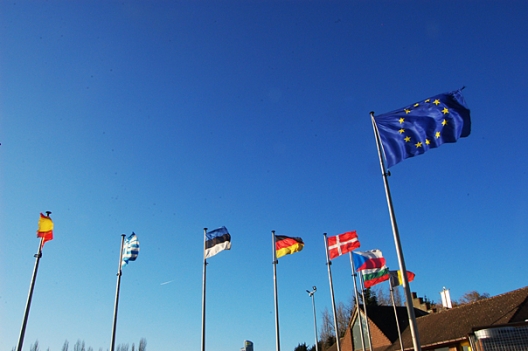 During the Cold War, against all odds and the tenets of realpolitik diplomacy, every White House and US Congress championed the cause of the ‘captive nations’ of central and eastern Europe locked behind the Iron Curtain. The accession over the next two decades of Poland, Estonia, and others to NATO and the European Union ended Cold War divisions and made the vision of a Europe whole and free a reality.
During the Cold War, against all odds and the tenets of realpolitik diplomacy, every White House and US Congress championed the cause of the ‘captive nations’ of central and eastern Europe locked behind the Iron Curtain. The accession over the next two decades of Poland, Estonia, and others to NATO and the European Union ended Cold War divisions and made the vision of a Europe whole and free a reality.
Unfortunately, Vladimir Putin’s ongoing effort to roll back freedom’s gains in Ukraine, Moldova, and Georgia puts them at risk of becoming today’s captive nations. To avoid marking the 25th anniversary of the fall of the Berlin Wall next year with the erection of a new wall separating a democratic and prosperous Europe from an authoritarian and kleptocratic Eurasia, the US must develop a strategy for Europe’s east.
As European leaders met in Vilnius, Lithuania, last week to chart the next chapter of European integration, the US did not have a seat at the table. However, the future of the EU’s relationship with six post-Soviet nations (Ukraine, Moldova, Belarus, Georgia, Azerbaijan, and Armenia) in the Eastern Partnership will have enormous strategic consequences for American interests.
The Eastern Partnership began as a modest effort to strengthen the ties of Europe’s east to the EU without offering membership. It has become the best way to foster transformation of post-Soviet nations by offering political affiliation, economic integration and elimination of barriers to travel with Europe. The partnership is driven by attraction, not coercion. Its powerful unspoken premise is that sovereignty requires democracy.
The Eastern Partnership is the latest expression of a common transatlantic grand strategy. The US and its allies nearly achieved their post-World War II goal of a free, undivided and peaceful Europe with post-Cold War NATO and EU enlargements, the twin pillars of this strategy.
The mixed results of the Vilnius summit underscore that this goal is in jeopardy.
Russia‘s threats in the lead up to Vilnius led Armenia and Ukraine to drop their bids for closer relations with the EU. Only Moldova and Georgia dared defy Moscow.
As the EU contemplates its next steps, the US has an opportunity to join with its European allies to increase the odds that these six post-Soviet nations have the option of a European future.
Traditionally, America has driven each wave of European integration, using NATO to pave the way for EU enlargement. Since Russia’s invasion of Georgia, Washington has stepped back from this role.
If the US sits on the sidelines, this next wave of European integration and ultimately enlargement will fail.
The task today is to develop a US strategy to complement and support EU efforts to integrate its neighbors in Europe’s east. America should be an enabler of European integration and a driver of NATO enlargement.
Washington should back the Eastern Partnership unequivocally to mitigate ambivalence within the EU, while strengthening the hands of its advocates. A divided Union will fail in integrating Europe’s east.
The US and EU should anticipate and counter Russian efforts to derail these nations’ move toward Europe. The EU has already expanded wine import quotas for Moldova, for example. Washington and Brussels should develop a package of incentives to support reformers, including committing to extend the Transatlantic Trade and Investment Partnership to any European nation that concludes a free trade agreement with the EU.
The US should also lead on security concerns afflicting these post-Soviet states, as the Eastern Partnership does not address these issues. This means intensifying military, intelligence and energy security cooperation with Ukraine. It means creating a security relationship with Moldova where none exists and leading the effort to demilitarize and reintegrate Transnistria, Moldova’s Moscow-backed breakaway region.
Washington should restore a strategy for Georgia to join NATO as long as the country’s new leadership pursues reforms rather than witch-hunts. The US can provide momentum to the integration process by galvanizing support for Macedonia and Montenegro’s acceptance into NATO, while also advocating for Bosnia and Herzegovina and Georgia’s accession into NATO’s Membership Action Plan.
A clear US strategy toward Europe’s east can give European leaders the confidence to take the politically-charged decision that the Eastern Partnership should become a pathway for successful reformers to pursue membership in the EU, an offer not yet on the table. Over the long-term, the vision of a Europe whole, free, prosperous and at peace includes a democratic Russia. But the pathway to reform in Moscow, and therefore a united Europe, might begin with pro-European choices made in Kiev, Chisinau, and Tbilisi.
Damon M. Wilson is executive vice president of the Atlantic Council.
Image: (Photo: Flickr/Motiqua)
